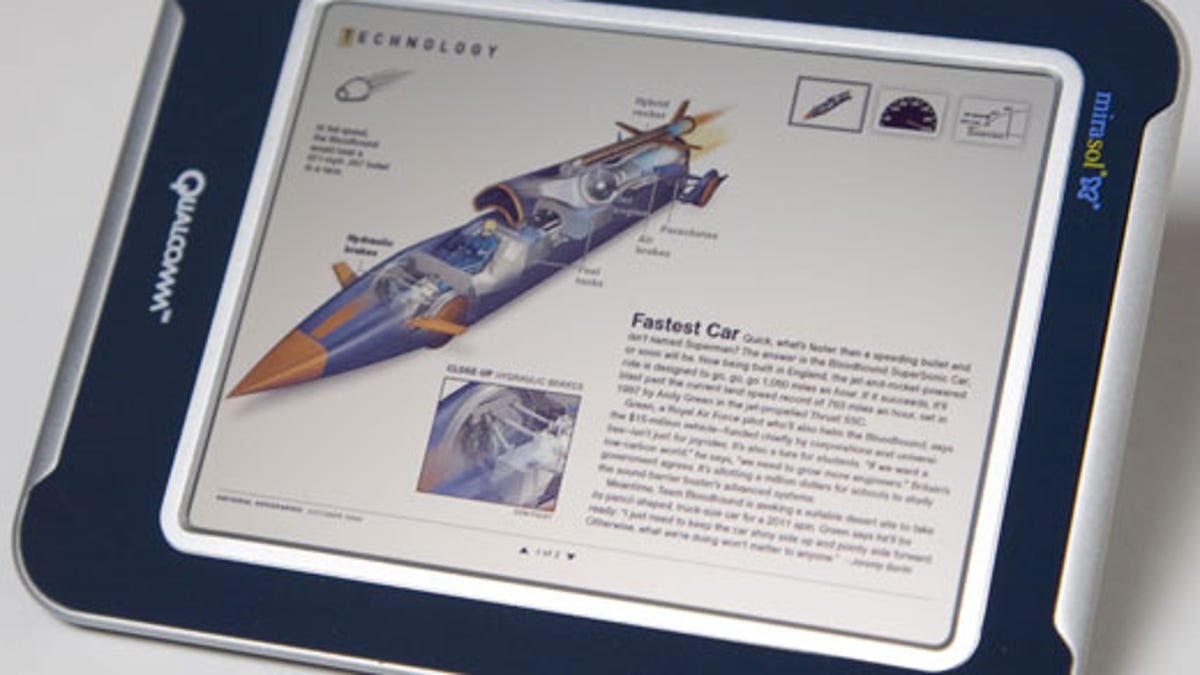What's next for e-readers: a Mirasol in the making?
Wondering what's on tap for e-readers in 2011? Here's a preview of what we expect to see at CES 2011 in Las Vegas in January.

At last year's CES, the e-reader product a lot of people were talking about didn't exist. It was a concept from Mirasol, a Qualcomm-backed company that was showing off its screen technology in a prototype unit.
Mirasol's screen caught people's attention for a few reasons. For starters, it was color. Secondly, its high-tech reflective display technology was not only energy-efficient but readable in direct sunlight. And finally, it was capable of displaying full-motion video. Marrying the best of what e-ink had to offer with some of the strengths of LCD, it looked a lot like the Holy Grail for e-readers and potentially other portable devices.
In August, word went out that Qualcomm was building a new factory to produce Mirasol displays at a cost of $2 billion. Then we heard chatter about a potentially big player releasing a Mirasol-based e-reader before year's end.
Qualcomm may very well be building a Mirasol factory, but a commercially available Mirasol e-reader didn't turn up in 2010, with the company sticking to its plan of licensing its technology rather than manufacturing its own hardware. Now, the big question is whether some company will announce it's got a Mirasol e-reader scheduled for release in 2011. And, just as importantly, how much will it cost?
Just a few weeks ago PocketBook USA, the North American division of PocketBook International, seemed to jump the gun, saying in a statement that it planned on releasing a new Mirasol e-reader simply called the Mirasol. However, PocketBook subsequently retracted the statement, which gave no details about the device beyond its name.
The Digital Reader blog that broke the news about the accidental press release then claimed to have spoken with some PocketBook sources who said that the device wouldn't be released until "Q3 of 2011" and that the Mirasol screens cost 1.5 times as much to make as e-ink screens. Also, a prototype device was only running video at 12 frames per second instead of the 24 to 30fps that's required for smooth motion playback (other reports have Mirasol reps debunking that statement).
What's true and what's not remains up in the air, but what we do know is that Mirasol will be exhibiting at the Digital Experience press event at CES on January 5, so we should have a lot more info then.
Mirasol, of course, is not the only new e-reader screen technology in town. Hanvon, a Chinese company, has already announced that it will be the first to ship a color E Ink e-reader next year, and we expect to see the technology, dubbed Triton, on display at the show.
While you can view color E Ink in direct sunlight, the knock against it is that its color is muted, it's not as sharp as LCD, and it's not capable of running full-motion video. According to the New York Times, Hanvon says its first color product will have a 9.68-inch touch screen and be available this March in China, starting at $440. That's about $150 less than what the entry-level iPad goes for in China. (It remains unclear whether the product will be released in the U.S.)
The other color screen technology to keep an eye on is Pixel Qi, which blends backlit LCD and e-ink display technology. The Notion Ink Adam tablet, powered by a custom, more tablet-friendly version of Android, was announced at the end of 2009 but finally became available for preorder very recently (in limited numbers). As editor Donald Bell reported, the "mythical tablet" comes in six models, ranging from a $375 Wi-Fi version with a standard LCD up to a $549 version using 3G and Pixel Qi touch-screen technology.
With a bevy of new tablets hitting the market next year--and many of them on display at CES--there will be plenty of questions over whether consumers will be more interested in multifunctional devices like the iPad or affordable dedicated e-readers like the
While a lot of the talk will be about color screens and Android, we do hope to see the continued evolution of monochrome e-ink, with higher-resolution devices that offer faster refresh rates. Also, with Sony finally coming through with touch-screen e-ink readers that work well, we should see more dedicated e-ink e-readers that use touch-screen technology.
Earlier this year E Ink rolled out its Pearl e-ink screen, which offers slightly improved contrast and readability (the latest Kindle and Sony Readers have Pearl screens). It's possible that we might catch a glimpse of E Ink's next-generation monochrome e-ink, but it should be noted that Pearl was unveiled in July, so it may be too soon to expect another upgrade.
As usual, what you see at CES isn't necessarily what you get. Only a few e-readers from the hodgepodge we saw last year actually made it to market and had any success. And say what you will about fancy screen technologies and cleverly designed products--the fact is that unless these products are priced attractively, they risk being overwhelmed by the next Kindle or Nook, or the iPad 2 (or whatever Apple calls it), which will most likely hit stores this April.
Comments?
More: The company behind Sony's e-reader touch-screen technology

